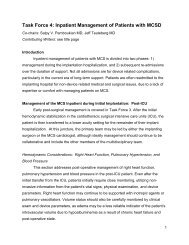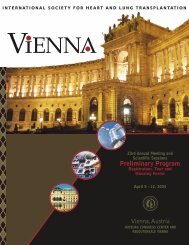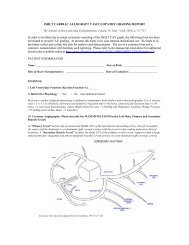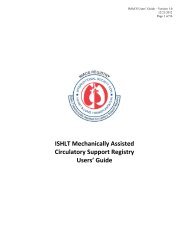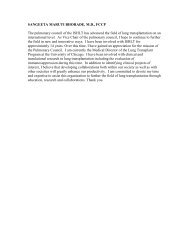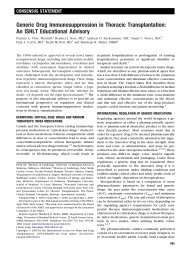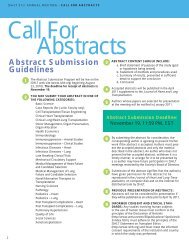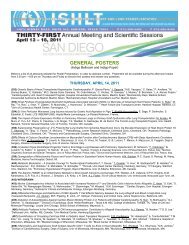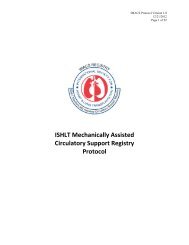Guidelines for the care of heart transplant recipients
Guidelines for the care of heart transplant recipients
Guidelines for the care of heart transplant recipients
You also want an ePaper? Increase the reach of your titles
YUMPU automatically turns print PDFs into web optimized ePapers that Google loves.
Costanzo et al.<br />
<strong>Guidelines</strong> <strong>for</strong> Heart Transplant Care<br />
935<br />
Class IIa:<br />
1. A baseline coronary angiogram at 4 to 6 weeks after HT<br />
may be considered to exclude donor coronary artery<br />
disease.<br />
Level <strong>of</strong> Evidence: C.<br />
2. IVUS in conjunction with coronary angiography with a<br />
baseline study at 4 to 6 weeks and at 1 year after HT is<br />
an option to exclude donor coronary artery disease, to<br />
detect rapidly progressive CAV, and provide prognostic<br />
in<strong>for</strong>mation.<br />
Level <strong>of</strong> Evidence: B.<br />
3. In HT <strong>recipients</strong> with established CAV, <strong>the</strong> substitution<br />
<strong>of</strong> MMF or AZA with a PSI can be considered.<br />
Level <strong>of</strong> Evidence: B.<br />
4. A PSI can been used in pediatric HT <strong>recipients</strong> who<br />
develop CAV, but <strong>the</strong> effect <strong>of</strong> PSI on <strong>the</strong> progression <strong>of</strong><br />
CAV in children is unknown.<br />
Level <strong>of</strong> Evidence: C.<br />
5. IVUS can be safely used in older pediatric HT <strong>recipients</strong><br />
to assess CAV.<br />
Level <strong>of</strong> Evidence: C.<br />
6. Evaluation <strong>of</strong> coronary flow reserve in conjunction with<br />
coronary angiography may be useful <strong>for</strong> <strong>the</strong> detection <strong>of</strong><br />
small-vessel coronary disease, which is a manifestation<br />
<strong>of</strong> CAV.<br />
Level <strong>of</strong> Evidence: C.<br />
7. Treadmill or dobutamine stress echocardiography and<br />
myocardial perfusion imaging may all be useful <strong>for</strong> <strong>the</strong><br />
detection <strong>of</strong> CAV in HT <strong>recipients</strong> unable to undergo<br />
invasive evaluation. Non-invasive testing <strong>for</strong> CAV is<br />
technically possible in children.<br />
Level <strong>of</strong> Evidence: B.<br />
8. Percutaneous coronary intervention with drug-eluting<br />
stents is recommended in both adults and children with<br />
CAV and <strong>of</strong>fers short-term palliation <strong>for</strong> appropriate<br />
discrete lesions.<br />
Level <strong>of</strong> Evidence: C.<br />
9. Surgical revascularization in HT <strong>recipients</strong> with CAV is<br />
an option in highly selected patients who have lesions<br />
amenable to surgical revascularization.<br />
Level <strong>of</strong> Evidence: C.<br />
10. Cardiac re<strong>transplant</strong>ation may be considered in patients<br />
with severe CAV and absence <strong>of</strong> contraindications <strong>for</strong><br />
repeat HT.<br />
Level <strong>of</strong> Evidence: C.<br />
Class IIb:<br />
1. Ultrafast computed tomography (CT) <strong>for</strong> <strong>the</strong> detection <strong>of</strong><br />
coronary calcium has been used mostly as an investigational<br />
tool <strong>for</strong> assessing CAV in HT <strong>recipients</strong>, but is<br />
being superseded by advances in CT angiography.<br />
Level <strong>of</strong> Evidence: C.<br />
2. CT coronary angiography shows promise in <strong>the</strong> evaluation<br />
<strong>of</strong> CAV in HT <strong>recipients</strong>, although higher resting<br />
<strong>heart</strong> rates in <strong>the</strong>se patients limit <strong>the</strong> technical quality <strong>of</strong><br />
this study.<br />
Level <strong>of</strong> Evidence: C.<br />
Topic 4: Malignancy After Heart Transplantation<br />
Recommendations on <strong>the</strong> Approach to Malignancy After<br />
Heart Transplantation: 268–271<br />
Class I:<br />
1. Recommendations regarding screening <strong>for</strong> breast, colon,<br />
and prostate cancer in <strong>the</strong> general population should also<br />
be followed in HT <strong>recipients</strong>.<br />
Level <strong>of</strong> Evidence: C.<br />
2. It is recommended that HT <strong>recipients</strong> have close skin<br />
cancer surveillance, including education on preventive<br />
measures and yearly dermatologic examinations.<br />
Level <strong>of</strong> Evidence: C.<br />
3. Initial evaluation and a <strong>the</strong>rapeutic plan <strong>for</strong> post-<strong>transplant</strong><br />
lymphoproliferative disorder (PTLD) in HT <strong>recipients</strong><br />
should be done at <strong>the</strong> <strong>transplant</strong> center by physicians<br />
familiar with <strong>transplant</strong>-associated malignancies.<br />
Level <strong>of</strong> Evidence: C.<br />
4. There is no evidence to support a reduction in immunosuppression<br />
in patients with solid tumors unrelated to <strong>the</strong><br />
lymphoid system. Maintenance immunosuppression<br />
should be continued unless <strong>the</strong>re are specific reasons to<br />
reduce certain drugs, such as reduction <strong>of</strong> bone marrowsuppressive<br />
agents if leucopenia occurs.<br />
Level <strong>of</strong> Evidence: C.<br />
Class IIa:<br />
1. Chronic immunosuppression should be minimized in HT<br />
<strong>recipients</strong> as possible, particularly in patients at high risk<br />
<strong>for</strong> malignancy.<br />
Level <strong>of</strong> Evidence: C.<br />
Topic 5: Chronic Kidney Disease After Heart<br />
Transplantation<br />
Recommendations on Chronic Kidney Disease After Heart<br />
Transplantation: 70,242–244,272–282<br />
Class I:<br />
1. Estimation <strong>of</strong> glomerular filtration rate (GFR) with <strong>the</strong><br />
modified diet in renal disease (MDRD) equation, urinalysis,<br />
and spot urine albumin/creatinine ratio should be<br />
obtained at least yearly after HT. Measurement <strong>of</strong> sCr <strong>for</strong><br />
estimation <strong>of</strong> GFR should be obtained more <strong>of</strong>ten in<br />
patients with GFR 60 ml/min/1.73 m 2 , and/or fast<br />
GFR decline in <strong>the</strong> past ( 4 ml/min/1.73 m 2 per year).<br />
Level <strong>of</strong> Evidence: C.<br />
2. Although in children <strong>the</strong>re is no consensus on <strong>the</strong> optimal<br />
method to estimate GFR, this measurement should<br />
be done and a urinalysis obtained at least yearly in<br />
pediatric HT <strong>recipients</strong>.<br />
Level <strong>of</strong> Evidence: C.<br />
3. Heart <strong>transplant</strong> <strong>recipients</strong> with an estimated GFR 30<br />
ml/min/1.73 m 2 , proteinuria 500 mg/day (or urine<br />
albumin/creatinine ratio 500 mg/g), or rapidly declining<br />
GFR ( 4 ml/min/1.73 m 2 per year), should be<br />
referred to a nephrologist <strong>for</strong> management <strong>of</strong> metabolic



